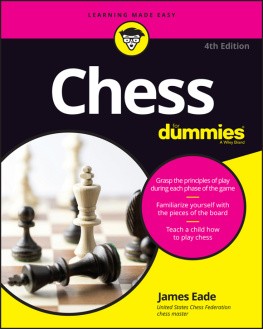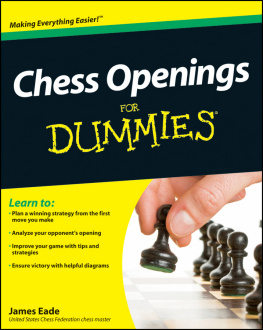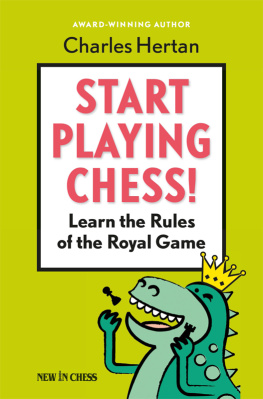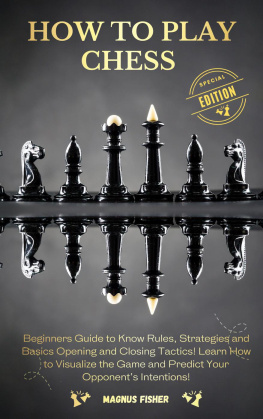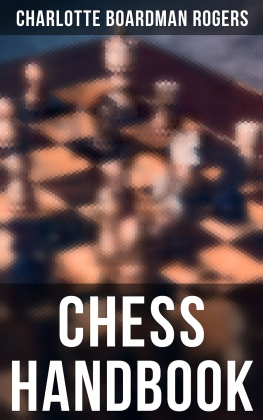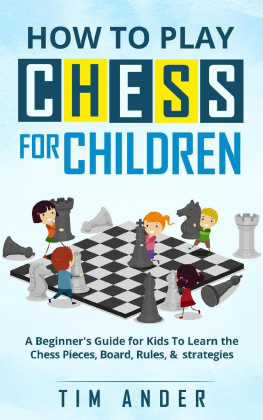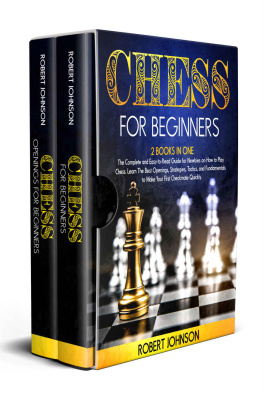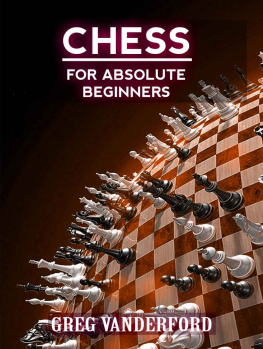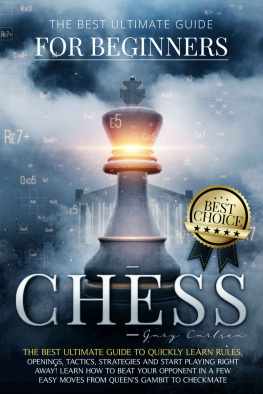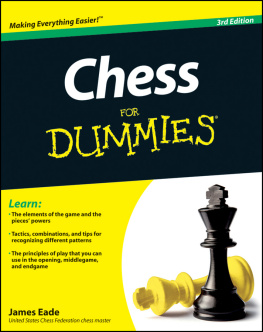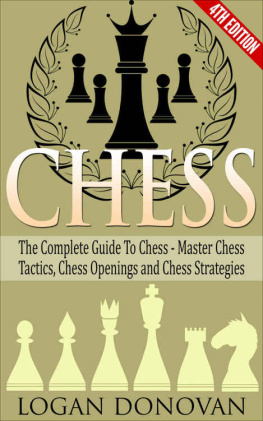
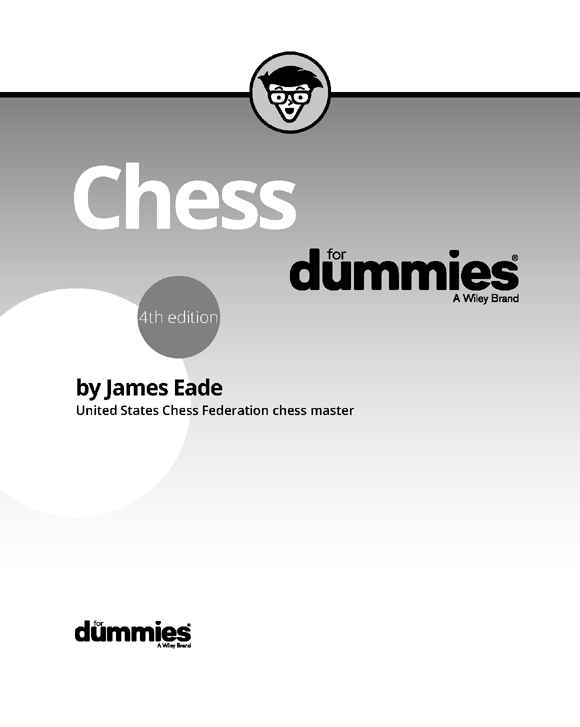
Chess For Dummies, 4th Edition
Published by: John Wiley & Sons, Inc., 111 River Street, Hoboken, NJ 07030-5774, www.wiley.com
Copyright 2016 by John Wiley & Sons, Inc., Hoboken, New Jersey
Published simultaneously in Canada
No part of this publication may be reproduced, stored in a retrieval system or transmitted in any form or by any means, electronic, mechanical, photocopying, recording, scanning or otherwise, except as permitted under Sections 107 or 108 of the 1976 United States Copyright Act, without the prior written permission of the Publisher. Requests to the Publisher for permission should be addressed to the Permissions Department, John Wiley & Sons, Inc., 111 River Street, Hoboken, NJ 07030, (201) 748-6011, fax (201) 748-6008, or online at http://www.wiley.com/go/permissions .
Trademarks: Wiley, For Dummies, the Dummies Man logo, Dummies.com, Making Everything Easier, and related trade dress are trademarks or registered trademarks of John Wiley & Sons, Inc., and may not be used without written permission. All other trademarks are the property of their respective owners. John Wiley & Sons, Inc., is not associated with any product or vendor mentioned in this book.
LIMIT OF LIABILITY/DISCLAIMER OF WARRANTY : WHILE THE PUBLISHER AND AUTHOR HAVE USED THEIR BEST EFFORTS IN PREPARING THIS BOOK, THEY MAKE NO REPRESENTATIONS OR WARRANTIES WITH RESPECT TO THE ACCURACY OR COMPLETENESS OF THE CONTENTS OF THIS BOOK AND SPECIFICALLY DISCLAIM ANY IMPLIED WARRANTIES OF MERCHANTABILITY OR FITNESS FOR A PARTICULAR PURPOSE. NO WARRANTY MAY BE CREATED OR EXTENDED BY SALES REPRESENTATIVES OR WRITTEN SALES MATERIALS. THE ADVICE AND STRATEGIES CONTAINED HEREIN MAY NOT BE SUITABLE FOR YOUR SITUATION. YOU SHOULD CONSULT WITH A PROFESSIONAL WHERE APPROPRIATE. NEITHER THE PUBLISHER NOR THE AUTHOR SHALL BE LIABLE FOR DAMAGES ARISING HEREFROM.
For general information on our other products and services, please contact our Customer Care Department within the U.S. at 877-762-2974, outside the U.S. at 317-572-3993, or fax 317-572-4002. For technical support, please visit https://hub.wiley.com/community/support/dummies .
Wiley publishes in a variety of print and electronic formats and by print-on-demand. Some material included with standard print versions of this book may not be included in e-books or in print-on-demand. If this book refers to media such as a CD or DVD that is not included in the version you purchased, you may download this material at http://booksupport.wiley.com . For more information about Wiley products, visit www.wiley.com .
Library of Congress Control Number: 2016945527
ISBN 978-1-119-28001-9 (pbk); ISBN 978-1-119-28003-3 (ePub); ISBN 978-1-119-28002-6 (ePDF)
Chess For Dummies
To view this book's Cheat Sheet, simply go to www.dummies.com and search for Chess in the Search box.
- Table of Contents
Guide
Pages
Introduction
Some chess players hate to hear someone call chess a game. They think that doing so trivializes what is actually a profound intellectual activity. Try as they may, however, chess enthusiasts seem incapable of convincingly placing chess solely in the context of art, science, or sport. Uncannily, chess contains elements of all three and yet chess remains a game.
Actually, I prefer to think of chess as a game the best game ever invented. Chess is a game loved by engineers and free-verse poets alike. It imposes a set of rules and has finite limits, but just as you start to think that youre finally solving its mysteries, it thwarts you. As a result, sometimes the game is frustrating, but far more often chess proves to be both surprising and delightful. The deeper you dig into chess, the more of its secrets you unearth but interestingly enough, the game has never been tapped out. Even todays monster computers are far from playing the theoretically perfect chess game.
To master chess, you must combine a kind of discipline normally associated with the hard sciences and a creative freedom akin to the inspiration of artists. Few people develop both aspects equally well, and few activities can help you do so. Chess, however, is one such activity. The methodical scientist is forced to tap into his creative energies to play well. The fanciful artist must, in turn, conform to certain specific principles or face the harsh reality of a lost game. Not only is chess an excellent educational tool that helps strengthen both sides of your brain, but the game is also an endless source of pleasure.
After most people discover that I play chess, they usually say, You must be very smart. They should instead say, You must have a lot of spare time. Chess has been played throughout history by people with above-average leisure time, not necessarily by people with far-above-average intelligence so if you dont consider yourself in the I-aced-the-MCAT crowd, fear no more.
As a matter of fact, chess tutors can teach preschoolers the rules of the game. (So maybe they cant get the tots to stop chewing on the pieces, but they can teach the youngsters how to play.) In fact, anyone can learn how to play chess with a bit of spare time. And you dont even need too much of that to learn the rules.
About This Book
This book is designed to help you become a better chess player in several ways:
- First, it contains a great deal of information and advice on how to play chess. You can read the book from cover to cover, or you can read only the sections or chapters that interest you its completely your call.
- You also find in these pages information about how to talk about chess, which, to many players, is at least as important as knowing how to play. (Part of the fun of chess is the social element involved in discussing other peoples games called kibitzing.)
- Finally, this book offers numerous suggestions on how to find other players who are just about at your own level (and how to mind your chess manners when you sit down to play!).
If youre a beginner, the great joys of chess await you. If youre an intermediate player, you can find in this book a wealth of material to help you improve your game and to enjoy chess even more.
Throughout this book, I use diagrams of actual chessboards to show the positions I discuss. This convention should sometimes eliminate the need for you to have a chessboard and set in order to use the book but even so, following along with an actual board and set is better. Just note that in these diagrams, the white pieces always start at the bottom of the chessboards, and the black pieces start at the top.
Here are a few other conventions to keep in mind:
- Throughout this book, I refer to moves with chess notation, which I usually place in parentheses. You can skip over this stuff if you dont want to find out how to decipher it, but if notation interests you, you can flip to whenever youre up to the challenge. (Understanding it really isnt tough, though believe me!)
- I use boldface to highlight the key words in bulleted lists and the action steps in numbered lists.
I use italics whenever I define a chess term. You can use the glossary as a quick reference for these terms, as well as a resource to discover other chess words.
When this book was printed, some web addresses may have needed to break across two lines of text. If that happened, rest assured that I havent put in any extra characters (such as hyphens) to indicate the break. So, when using one of these web addresses, just type in exactly what you see in this book, pretending as though the line break doesnt exist.
Next page
